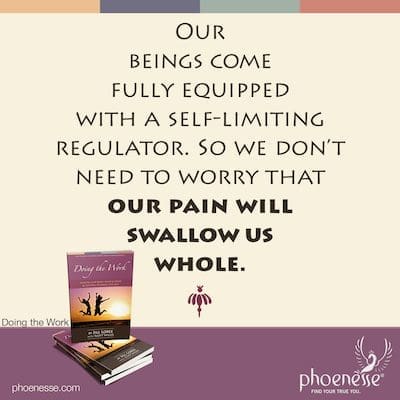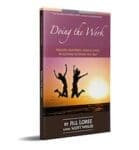Emptying Out the Well

Prayer and meditation are vital for seeing new truth and gaining a new perspective. We can also use them to develop the ability to become quiet within. We do this so we can hear the anxious parts of us when they become activated. For most of us, our inner clamoring and rationalizations have become so loud, and yet so familiar, we don’t notice the blinking lights telling us something is coming up for healing.
One of those blinking lights is anger. There is indeed healthy, justified anger that fuels us to stand up for what’s good and right in the world. But more typically, our anger is the old and moldy variety that seethes with self-righteousness. And that kind is a handy cover for our pain. When we begin to truly express this kind of anger, then our feelings can start to shift. This is what we do in healing sessions with a spiritual Helper, instead of just recycling our case against someone. The anger morphs as it moves, and other buried emotions find space for expression.
Our feelings, shoved down deep into our psyches, have had no breathing room for quite some time. Eons, probably. When anger arises, then, that’s our opportunity to get to know ourselves. This includes all our contradictory Emotional Reactions that are slowly tearing our insides apart.
When we tap into our inner reservoir of pain, it may feel like we have found a bottomless pit. It may indeed be vast, but there is in fact an end. And we won’t ever get to it unless we become willing to initiate the process of emptying the well. It’s not enough to dip a toe in and call it a day. Each time inconvenient feelings well up, our work is to meet them as full-face-on as we can. Doing the work means going all the way through them and coming out the other side.
Note, our beings come fully equipped with a self-limiting regulator. So we don’t need to worry that our pain will swallow us whole. It only feels that way when we are in resistance to feeling our pain. The pressure gradually lets off once we’ve gone some distance and made a little progress.
That’s a good reason to go on a healing adventure following the guidance of a trained spiritual counselor. Such a person can hold the flashlight as we bravely venture into the dark, difficult crannies of our inner world.

When we were little, we had needs that were not met, and our unwillingness to feel the resulting pain has caused a backlog of pain to build up in our system. The only way to release this residual pain held by our split-off inner aspects is by doing the hard inner work of letting it go. Yes, we’re going to have to cry it out.
There is a spiritual law that says we cannot cheat life. If we weren’t willing or able to feel these difficult feelings then, we must go the distance in feeling them now. To further avoid our work is to create higher mountains we’ll someday have to climb. We won’t get it all in one go, but now is the time to breathe and go on in.
Also, there’s no need to climb the tallest emotional cliff we can find and leap from there. More to the point, we shouldn’t do that. We need to develop some spiritual muscle—as well as some spiritual stamina—to be able to tolerate difficult feelings as we grow into our ability to move through them. This may not be as easy as it sounds. It’s also really not that hard. We just need to cultivate an inner ability to be with what is, even when that challenges us. We must discover, for ourselves, that our feelings aren’t facts—they will change and mature the more we experience them—and getting to know them won’t kill us.
Our goal is to clear away all our blocks—our residual pain—so we can once again live in harmony with all that is. Recall that every inner disharmony is rooted in untruth, meaning no one who hangs out in untruth can ever be truly happy. We must make the choice to unclench our grip on being right, and instead choose the way that leads to freedom. There is nothing standing in our way except us.
In Jill’s Experience
I spent my early years of doing this work by resisting crying. It’s funny how we talk about something being so bad, it actually made someone cry. Today I think “Yay!” when someone is able to access their feelings and express their tears. Because what I have come to realize is that nothing melts a frozen heart like a bath of tears.
Typically, to stay strong, we clamp down—in fact, often while doing this work, we need to release the tension in our jaw resulting from this—and hold ourselves back. It’s that child part of us that doesn’t want to let them win. But the truth is, we are so much stronger when we have access to all of ourselves. And if our heart’s a frozen block of ice, we’re not fully alive.
Sitting in that workshop about delving into sexual fantasy, I was a rock, but not in a good way. My body was tense, my shoulders were stiff, and my energy was out the door and down the street. To say I was beside myself with trepidation would be generous, for much of me was nowhere in sight.
Then someone started sharing about a sad experience involving the poor treatment of children. The pain of it touched my heart, and as my tears came, I felt my heart begin to soften and melt. The more I allowed my feelings to surface, the more alive I felt. I felt myself arrive, with much more of me finally present in the room. Tears, I learned, are my gateway to finding myself.
That palpable and visceral experience was pivotal for me in my work. No longer did I think of crying as the problem; I saw that it was the solution. It’s what has needed to happen for me to come back and re-join myself. And it’s this connection I feel to my own heart that gives me a resource from which I can give to others. For we can’t give to anyone else what we don’t have for ourselves.
In Scott’s Experience
I think socially it’s harder for men to enter the realm of feelings, at least in the US. There aren’t many social settings where men get together and cry. This may be socially “normal” for men, but it’s not natural. Feelings take some time to re-learn for us.
I still vividly remember the first time I tried to stand up in front of a group and process through a difficult emotional place in me. I knew I was stuck with a particular issue and I wanted to move through it, to feel the feelings and pain involved there. By then, I had seen my peers take this step, and with a gulp of courage I stood up to take my turn. Then I froze. To an outside observer, it looked like a complete non-event.
On the inside, I experienced something completely new. One part of me stepped forward and, in front of a group, tried to access my feelings. Another part of me stepped back and tried to hide. In that moment, I felt the separation and realized there were multiple parts of me. I was a bit embarrassed at not “succeeding,” but it was an epiphany.
The way forward for me was to use my positive will. I created a prayer affirmation that said, “I want to feel my real feelings, without either suppressing or embellishing them. I want to feel what I really feel”. Then I said this prayer morning and night for perhaps a month until the dam burst. I cried multiple times a day for a long while. Turns out I had built a lot of dams over the years, and had to release them one by one. But that first one was the toughest.
One of the dams I had built was of grief and sorrow over my mother’s illness and death when I was young. I had created an emotional sterility around her. When I came into that inner space again and again, I encountered an acute pain of grief that was very difficult to be with. It felt like I was being gutted like a fish, and that the hurt would never end.
I kept working with it, and one day, I felt sorrow. It was cleansed of the hard pain and was just pure sorrow. I was surprised to find that sorrow in its pure form has a vibrant aliveness to it. In an astonishing moment for me, I realized that pure sorrow is quite bearable, even in very large doses. It was the hard pain—mixed in from resisting my real feelings for so many years—that was difficult to bear.
Why go through all this effort? Why not just be with the joys of life instead? While it would be nice to be able to feel vibrant joy while being able to bypass acute grief and sorrow, it doesn’t work that way.
Turns out, you either feel your feelings, or you don’t.
You can’t select one and bypass the others. If you clamp down on grief, the lid shuts tight on it all, and you can’t feel joy in the next moment. I have learned then that the way to become able to feel boundless joy—which is a growing experience for me—is to become capable of feeling intense sorrow.
Next Chapter
Return to Doing the Work Contents


